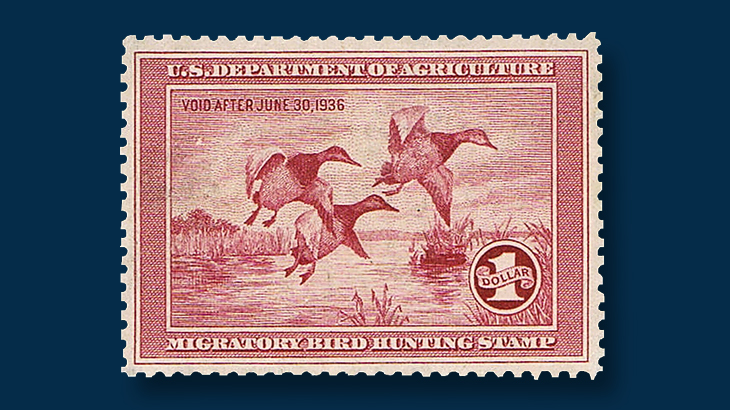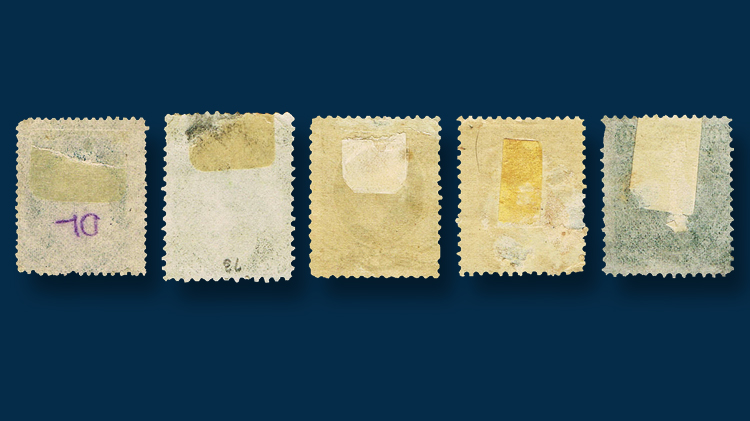US Stamps
Personal standards and expertizing
U.S. Stamp Notes — By John M. Hotchner
Linn’s reader Bob Finch recently wrote in with questions about hinges. Here is his email: “I am having, and have always had, significant difficulty regarding stamp hinges attached to some of my purchases, and in my collection. I can find no definitive guidance regarding how to deal with them! I’ve looked at a gazillion ‘how to’ books and publications but nobody seems to want to provide real guidance on this subject. For example, if the hinge is ‘sticky’ and can’t be removed, should it be left intact or trimmed off so that the stamp can be mounted? There seem to be volumes written on the chemistry of adhesives, but little about the practical, real-life problems of dealing with hinges …
“Here’s a specific example of my concern. Had an excellent RW2, which had a clunky hinge remnant on the original gum. Used my humidity ‘box’ to soften the gum so I could remove the hinge. Easily removed it with no damage, and the gum smoothed by itself since it was moist — gorgeous result!
“An expertizing house called it Disturbed Original Gum (DOG), which is correct, but hurts the value big-time. This is what I’m trying to address.”
The expertizer strives for accuracy without regard to value. So the disturbed gum description is indeed the correct thing to do. But the buyer of stamps has other considerations. One, the value of the stamp, is obvious. The other, what pleases the senses, may not be, though it is clear from reading Finch’s note that it is of significant concern to him.
What he seems to be asking is if it is possible to enhance the value of the stamp through making it more attractive by carefully removing a hinge.
He likely accomplished that end with his 1935 federal duck stamp (Scott RW2), with an example shown in Figure 1, but there is a limit. And that limit is that there is no way to remove the hinge without leaving a tell-tale gum disturbance. No wonder he can’t find anything in the literature that gives instructions on doing so.
Now, this is not to say that people don’t try; which is where the expertizer comes in. I have seen some pretty good efforts — and I have no doubt that some have been good enough to pass even the most careful expertizer. But willfully submitting a stamp as “full original gum” when the owner knows that is not the case is fraud, and “How to commit fraud” is not going to be a chapter heading in “How to” books.
Here I must mention that Finch submitted his stamp noting that it was “hinge removed” and is assuredly not guilty of fraudulent intent. Unfortunately, not everyone is that honest.
The absence of gum disturbance is not the only thing an expertizer looks at. See some examples of hinged stamps in Figure 2.
The presence of a hinge can also be a red flag when it covers a pin hole or a thin, or masks a regumming job — especially seen on early mint U.S stamps, but damage on used stamps can also be covered by hinges. Here, dipping in watermark fluid can be the expertizer’s friend.
How each of us deals with hinges is influenced by both value and attractiveness considerations: preserving maximum value, while having the stamp appeal to the collector as a fit item to fill the space in their album. I can reflect on my own practices, but I can’t tell anyone else how to resolve the possibly conflicting considerations.
Let us first posit that there is inherent risk in removing hinges. I use only Denison hinges for my album collections for both for used and for inexpensive mint.
The primary virtue of Denison hinges is that they are, carefully, peelable. The bad news is that they are no longer produced. Nothing now produced is quite as good, and many products are inferior. I was lucky to have found a dealer with a small horde of them many years ago, and what I will do when I run out is a question that bothers me.
But the question really is what to do with stamps you buy that have heavy, unpeelable hinges.
Perhaps, if you don’t much care about the back of stamps, the answer is “nothing” other than to be aware that there may be damage underneath, and to act accordingly.
If the stamp has considerable value, you might ask the seller to get it expertized; or do that yourself after establishing an agreement with the seller as to who pays if the stamp comes back with a bad or “damaged” certificate.
Keep in mind that unless you give specific permission, expertizers will not attempt to remove hinges, and some will not remove hinges even if you do give permission.
I am not a purist who will accept only never-hinged stamps. I am not buying with an eye to resell, nor do I feel that I need to worry excessively about the part of the stamp I don’t display. So, my practice is to do the best I can before adding a new acquisition to an album; not to require a pristine back.
But if you do care about the backs, or if the hinging obscures being able to check for a watermark, there are a few alternatives: The sweatbox for mint stamps, and washing the hinges off for used.
Connect with Linn’s Stamp News:
Sign up for our newsletter
Like us on Facebook
Follow us on Twitter
My own method is to wash used stamps in warm water and to remove by hand what I can of hinges on mint stamps, taking care not to pull stamp paper off the back.
I use eyebrow tweezers to remove the part of the hinge that sometimes overhangs the top of the stamp as regular stamp tongs often don’t have enough grip. But if you are going to try this, practice on some cheap stamps before you try it on a more desirable example.
Rarely, it is impossible to remove hinges from old, used stamps. Either the hinging material or the adhesive itself are bonded like iron and just can’t be separated.
I know of no published source that provides uniform guidance or even comprehensive recommendations, and that is probably because what you may want to do depends a great deal upon your personal collecting standards.
Each stamp is its own problem with its own unique circumstances, type of hinge, type of gum, and degree of disturbance already present.
Is the potential increase in value over the hinged version worth the effort and risk to take the hinge off? We can torture ourselves with unanswerable questions, but eventually, we have to get comfortable with the fact that we will have to make value judgments, and there is no guide except your own knowledge and experience.
In expertizing, I evaluate the stamp for catalog number and to answer the submitter’s question or questions without altering the state of hinges present. There are rare instances where I can’t do what is asked because of the presence of the hinge or multiple hinges, but I cannot remember the last time. So it is not a pressing problem.
MORE RELATED ARTICLES
Headlines
-
US Stamps
Oct 7, 2024, 3 PMMcMurtrie dismissed as APS education director following Sept. 21 arrest
-
US Stamps
Oct 7, 2024, 12 PMVasiliauskas named president of Mystic Stamp Co.
-
US Stamps
Oct 6, 2024, 5 PMApgar souvenir card available
-
US Stamps
Oct 6, 2024, 4 PMFirst Continental Congress and U.N. stamps receive Scott catalog numbers










